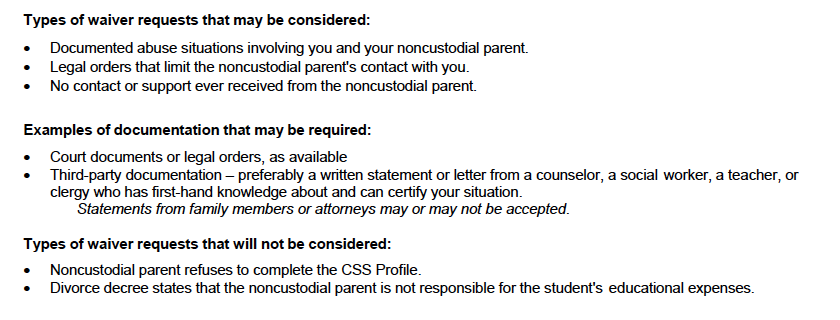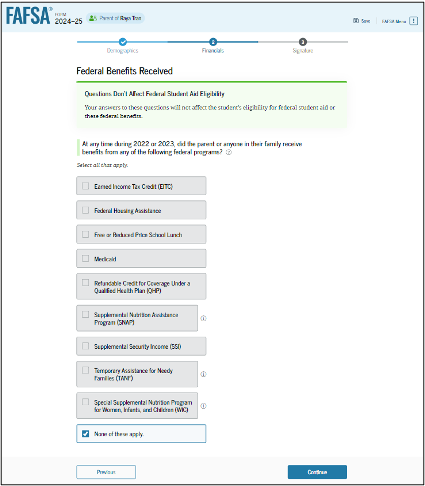What is the Student Aid Index?
The 2026-27 FAFSA, or Free Application for Federal Student Aid, is the primary application for need-based financial aid for the 2026-27 academic year. A student and one or more parents submit household and financial information. Based on this information, the FAFSA calculates the amount a family can pay for college in a given year, called the Student Aid Index (SAI).
A college’s financial aid office uses the Student Aid Index in the simple equation below to determine a student’s eligibility for need-based financial aid, given the college’s Cost of Attendance.
Cost of Attendance
– Student Aid Index (SAI)
_____________________________
= Financial Need
A student’s Financial Need is their eligibility for aid at a college. However, each college’s policies on allocating their institutional need-based funds determine the financial aid offer a student will ultimately receive, which may or may not meet a student’s calculated Financial Need. Read more
How is the Student Aid Index calculated?
Family size, parents’ marital status, state of residence, along with four primary financial inputs, determine the 2026-27 Student Aid Index.
- Parent 2024 Income
- Parent Assets on date of filing
- Student 2024 Income
- Student Assets on date of filing
One significant change is the number of students in college will no longer be used in the SAI formula.
1) Parent Income
The 2026-27 FAFSA relies on 2024 federal tax returns for all parent income, eliminating the reporting of non-taxed income not included on the federal tax returns. Pre-tax contributions to employer-sponsored retirement plans – 401k, 403b, Pension, etc… – no longer count as part of parent income.
If the parent is not required to file federal tax returns in 2024, then the SAI = -$1,500. This step is incorporated as part of this calculator. Read more
2) Parent Assets
The 2026-27 FAFSA counts the following assets as part of a parent’s net worth available to pay for college:
- Checking
- Savings/Money Market Accounts
- CDs
- Brokerage accounts
- 529 or college savings plans only for the student applicant
- Equity value of second properties.
Two additional categories can be counted as parent assets for the calculation of SAI.
- Child support received.
A parent reports all child support received in the calendar year before filing the FAFSA as an asset. - Net worth of business or farm.
If a parent owns a business or farm that employs more than 100 full-time employees, then the net worth is reported on the FAFSA. The net worth is the value of the business or farm minus any debt against that business or farm. A parent who is only a part owner would report their percentage of the overall net worth.
Protected assets are not counted on the FAFSA:
- Retirement Accounts – 401k, 403b, IRAs, Pensions, etc…
- Life insurance
- Primary home
The contribution rate from the total net worth of parent assets reported is roughly 5%.
3) Student Income
The 2026-27 FAFSA provides income protection for a student equal to $11,770. So, there is no expected contribution from student income if 2024 income is $11,770 or less. For every dollar over this amount, the contribution rate is 50%.
4) Student Assets
All assets held by a student outside of retirement are reported. These include checking, savings, CDs, and brokerage accounts. 529 or college savings plans owned by the student are always reported as a parent asset. The contribution rate for student assets is 20% of every dollar.
2026-27 FAFSA Student Aid Index Calculator
To calculate your Student Aid Index, use values from the parent’s and student’s 2024 tax returns and the current value of parent and student assets. Note: This calculator is for dependent students.
How was this calculator developed?
This calculator follows the updated 2026-27 Student Aid Index formula published by the Department of Education in August 2025. You can download the formula sheet here.
What does a negative SAI mean?
The Student Aid Index can now be as low as -$1,500. To determine a student’s eligibility (Cost of Attendance – SAI = Financial Need/Eligibility), colleges will set the SAI to equal $0. However, the college may consider a negative SAI in evaluating college-based programs for high-need students.


